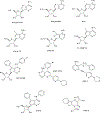Adenosine kinase: A key regulator of purinergic physiology
- PMID: 33161022
- PMCID: PMC8096637
- DOI: 10.1016/j.bcp.2020.114321
Adenosine kinase: A key regulator of purinergic physiology
Abstract
Adenosine (ADO) is an essential biomolecule for life that provides critical regulation of energy utilization and homeostasis. Adenosine kinase (ADK) is an evolutionary ancient ribokinase derived from bacterial sugar kinases that is widely expressed in all forms of life, tissues and organ systems that tightly regulates intracellular and extracellular ADO concentrations. The facile ability of ADK to alter ADO availability provides a "site and event" specificity to the endogenous protective effects of ADO in situations of cellular stress. In addition to modulating the ability of ADO to activate its cognate receptors (P1 receptors), nuclear ADK isoform activity has been linked to epigenetic mechanisms based on transmethylation pathways. Previous drug discovery research has targeted ADK inhibition as a therapeutic approach to manage epilepsy, pain, and inflammation. These efforts generated multiple classes of highly potent and selective inhibitors. However, clinical development of early ADK inhibitors was stopped due to apparent mechanistic toxicity and the lack of suitable translational markers. New insights regarding the potential role of the nuclear ADK isoform (ADK-Long) in the epigenetic modulation of maladaptive DNA methylation offers the possibility of identifying novel ADK-isoform selective inhibitors and new interventional strategies that are independent of ADO receptor activation.
Keywords: Adenosine; Adenosine Kinase; Analgesia; Inflammation; Motor activity; Seizures.
Copyright © 2020 Elsevier Inc. All rights reserved.
Conflict of interest statement
Figures


References
-
- Burnstock G, The therapeutic potential of purinergic signalling, Biochem Pharmacol 151 (2018) 157–165. - PubMed
-
- Miller SL, Urey HC, Origin of Life, Science 130(3389) (1959) 1622–1624. - PubMed
-
- Miller SL, Urey HC, Organic compound synthesis on the primitive earth, Science 130(3370) (1959) 245–51. - PubMed
-
- Newby AC, Adenosine and the concept of ‘retaliatory metabolites’. Trends Biochem Sci 9(2) (1984) 42–44.
Publication types
MeSH terms
Substances
Grants and funding
LinkOut - more resources
Full Text Sources
Other Literature Sources
Molecular Biology Databases
Miscellaneous

